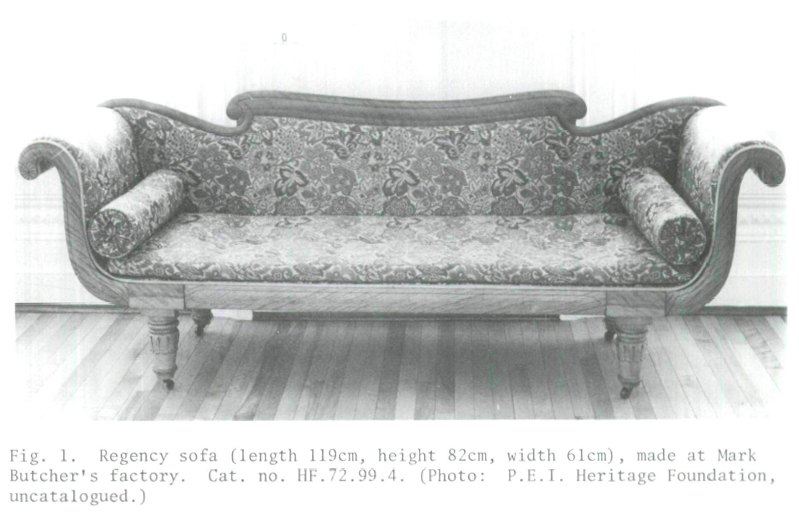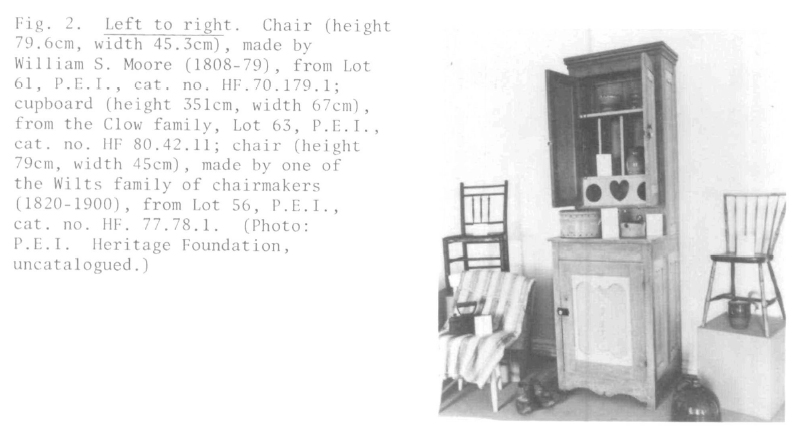Furniture in Public Collections in Canada / La Collection Nationale de Mobilier
Prince Edward Island Heritage Foundation
1 The Prince Edward Island Heritage Foundation furniture collection began to be developed only eight years ago but today it includes more than 3,000 pieces. Fortunately the foundation was able to take advantage of a research project on Island furniture begun five years before and that information helped considerably in developing the acquisition policy that has evolved.
2 By the middle of the nineteenth century Prince Edward Island, like other British North American colonies, was developing its self-sufficiency. The familiar phrase "encourage home manufacturing" stood out in most of the newspaper advertisements. As in other areas there were itinerant furniture makers, centrally-located chairmakers, and commercial establishments that hired anywhere from two to sixty men. More than seventy-five furniture makers have been documented and at least thirty are now represented in the foundation's collection.
3 The history of Island manufacturing nearly slipped away from us. So very often pieces of furniture are introduced by such statements as "It came from England" or "They brought it on the ship when they came." It has generally been accepted that nothing fine could have been made here or, if it is something very primitive, that it would be Acadian. What satisfaction, after that kind of an introduction, to turn over a chair and find a label reading "Made in Prince Edward Island" or marked with a set of initials that can be identified. All this, of course, is reason enough for a province to preserve its past.
4 The collecting policy of the Heritage Foundation is to acquire Island-made objects reflecting the industrial independence of another time, Island crafts and artwork, and objects used by significant Islanders or connected with particular historic events. With discretion and care the furniture collection has grown into something to be proud of.
5 The Island's most prolific cabinetmaker, Mark Butcher (1814-83), operated a factory in Charlottetown employing at times over sixty men. The collection has many labelled pieces from his factory and many more unlabelled; an exceptionally fine parlor set, linen press, dresser, and reading chair are a few examples. Although of traditional design the quality of the work from Butcher's factory was certainly high. Examples of his work can also be found in the Government House collection, Province House, and the provincial court house. The export trade took his products to each of the other Atlantic provinces as well as to New England.
 Display large image of Figure 1
Display large image of Figure 16 Furniture factories operated by Dogherty, Douglas, Newson, Wright, Compton, and Webber made a wide range of furnishings, of varying degrees of craftsmanship, for schools, homes, and offices. These factories operated either in Charlottetown or Summerside up until the early years of the twentieth century. The quantity of pieces produced locally compared to the number of pieces imported whole or in parts to be assembled varied from factory to factory. Furniture from each of these businesses has been acquired by the foundation.
7 Many of the most interesting pieces in the collection come from individual furniture makers and, of course, are more difficult to document. The earliest cabinetmaker represented is Benjamin Chappell (1740-1825) — early Island settler, postmaster, lay preacher, and wheelwright. Although he made hundreds of spinning wheels, the foundation's example of his work is a beautiful wooden armchair that came from a descendant.
8 Certain factors have limited the collection in the area of simple country pieces. Emphasis has been placed on furniture with original finishes or pieces with some clear connection with a particular area of the province. The province has lost many special pieces to the strip tanks. However, the mandate to furnish an 1864 home and an 1895 combination house and store as heritage sites and to upgrade the furnishings of the province's 1834 Government House has aided considerably in broadening the collection. Pieces that may not have exactly fitted the collection policy now grace these three sites. The Government House collection is of particular significance since some of the pieces remain from the original inventory. The complete furnishings for the public rooms came from the firm of Thomas and George Seddon of London, England, in 1837.
 Display large image of Figure 2
Display large image of Figure 29 As in other areas of the country, the exodus of undocumented furniture that has left the Island over the last twenty years is a sad commentary on interest in material history. Little effort was made on the part of most pickers and collectors to connect the story with the object and so precious pieces of history have vanished, never to return or even to enrich the lives of people in other places who have acquired them. How slow we were, how unappreciative of such a rich heritage.